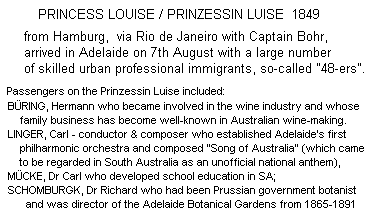PRINCESS LOUISE / PRINZESSIN LUISE 1849 |
arrived Port Adelaide on 7-08-1849 The Advertiser (December 2nd, 1989): "She was a ship of destiny. Her passengers would leave an indelible imprint on our State, its culture and its heritage. Yet, when the Princess Louise sailed from Hamburg, in the spring of 1849, bound for South Australia, her cabins crammed with 162 men, women and children, few could guess at the extraordinary impact the passengers would have on the new colony. ..." |

|
PRINCESS LOUISE 1849 - PASSENGERS LIST
the SA Maritime Museum (some of which has since proven to be incorrect) and private research. |
|
The story of the PRINCESS LOUISE began in Berlin in the late 1840s, during a period of revolution. At that time, Europe, spurrred by the earlier French Revolution, was facing a period of change, revolt, and uprising. In Berlin, in 1848, Richard Schomburgk, a gardener who had established a reputation as a botantist, and his physician brother, Otto, saw that there was little hope of their dream of democracy being achieved and, by 1849, a period of repression began. ... The brothers formed a migration group, calling it the Berlin Emigration Society (other references say: South Australian Colonisation Society), and made plans to leave the Fatherland for a new start in Australia. ... So, in March, 1849, the Society chartered the PRINCESS LOUISE and set sail for Adelaide with a new wave of refugees, arriving in Port Adelaide on 7 August 1849. The Society was largely comprised of professional men, businessmen and skilled artisans, and has been called "the single most important group of German intellectuals to come to Adelaide". Alexander von Humboldt had always been fond of the Schomburgk brothers. He had backed Robert Hermann’s journey to Guayana from 1835 to 1839 and had later written the preface to his travel journal. Otto Schomburgk, a third very talented brother, was tormented by Mr. von Kamptz, and in 1839 arrested for his political activities and incarcerated in a fortress. Otto was soon free again after Humboldt intervened at the Prussian court. With a letter of recommendation Humboldt had also supported the publication of a travel journal written by Richard Schomburgk, who had accompanied his brother Robert Hermann on a journey to British Guayana from 1840 to 1844.[2] And finally, Humboldt and his friend, the geologist Leopold von Buch, had helped to secure financial backing for the costly voyage to Australia of two of the Schomburgk brothers. In a letter to the astronomer Friedrich Wilhelm Bessel, written on August 11th 1844, Humboldt describes his relationship with the Schomburgk brothers in vivid terms: „It will be a great joy to me when you confer a doctorate to Robert H. Schomburgk during the celebration. He is a man, who, completely self taught and with a lot of hard work and exposed to great dangers [...] discovered and opened up an important part of South America. His geographical and natural history collections are equally important. And on top of that he is a kind man, highly regarded by our royal couple; a man who has enriched our museums without any reimbursements. He has been in London since July to complete the trigonometric map of British Guyana. His younger brother Richard, who the king sent out as botanist and gardener has proved to be equally bright. He has just brought back the greatest collection of living palms and orchids the botanic garden has ever received, as well as live animals from the Rio Essequibo and beautiful collections of stuffed birds and mammals, fishes in alcohol and minerals.It is a very distinguished family, in which a small demagogue should not be missing, if only as an ornament.“ Together with their wives, Otto and Richard Schomburgk arrived in Port Adelaide on August 6th 1849. The meteorological diary Otto Schomburgk had kept during the long voyage provides us with all the data on their date of arrival: southwesterly winds, water temperature 11.6 degrees Réaumur (i.e. 14 degrees Celsius) air-temperature at 2 pm 10 degrees (12.5 C). If one compares these temperatures to the ones they had measured on their date of departure from Hamburg on April 14th - they are nearly the same. These two brothers, received their scientific training and promotion in the circle surrounding Alexander von Humboldt. They did not come to South Australia as explorers though. They were immigrants seeking a new livelihood for themselves and their families. But their endeavor to report on the newly settled continent in a scientific manner was not at all diminished by this fact. From the very beginning the brothers had to meet two challenges: They had to survive as gardeners and farmers under largely unfamiliar conditions and they had to live up to the expectations of the Berlin Academy of Sciences, which had supported them financially. In a letter Otto Schomburgk wrote to Alexander von Humboldt on December 25/26th 1849 this objective is expressed in the following words: "[...] that here, too, all our efforts and endeavors will be focused on making ourselves worthy of the love you have shown us, as it will always be our aspiration, as much as it is within our feeble powers, to contribute to the expansion of the realm of sciences, which honour you as their great and unparalleled master". |
